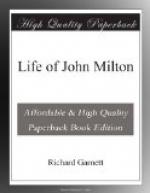The “Penseroso” and the “Allegro,” notwithstanding that each piece is the antithesis of the other, are complementary rather than contrary, and may be, in a sense, regarded as one poem, whose theme is the praise of the reasonable life. It resembles one of those pictures in which the effect is gained by contrasted masses of light and shade, but each is more nicely mellowed and interfused with the qualities of the other than it lies within the resources of pictorial skill to effect. Mirth has an undertone of gravity, and melancholy of cheerfulness. There is no antagonism between the states of mind depicted; and no rational lover, whether of contemplation or of recreation, would find any difficulty in combining the two. The limpidity of the diction is even more striking than its beauty. Never were ideas of such dignity embodied in verse so easy and familiar, and with such apparent absence of effort. The landscape-painting is that of the seventeenth century, absolutely true in broad effects, sometimes ill-defined and even inaccurate in minute details. Some of these blemishes are terrible in nineteenth-century eyes, accustomed to the photography of our Brownings and Patmores. Milton would probably have made light of them, and perhaps we owe him some thanks for thus practically refuting the heresy that inspiration implies infallibility. Yet the poetry of his blindness abounds with proof that he had made excellent use of his eyes while he had them, and no part of his poetry wants instances of subtle and delicate observation worthy of the most scrutinizing modern:—
“Thee, chantress, oft the
woods among,
I woo, to hear thy evensong;
And, missing thee, I walk
unseen
On the dry, smooth-shaven
green.”
“The song of the nightingale,” remarks Peacock, “ceases about the time the grass is mown.” The charm, however, is less in such detached beauties, however exquisite, than in the condensed opulence—“every epithet a text for a canto,” says Macaulay—and in the general impression of “plain living and high thinking,” pursued in the midst of every charm of nature and every refinement of culture, combining the ideal of Horton with the ideal of Cambridge.




